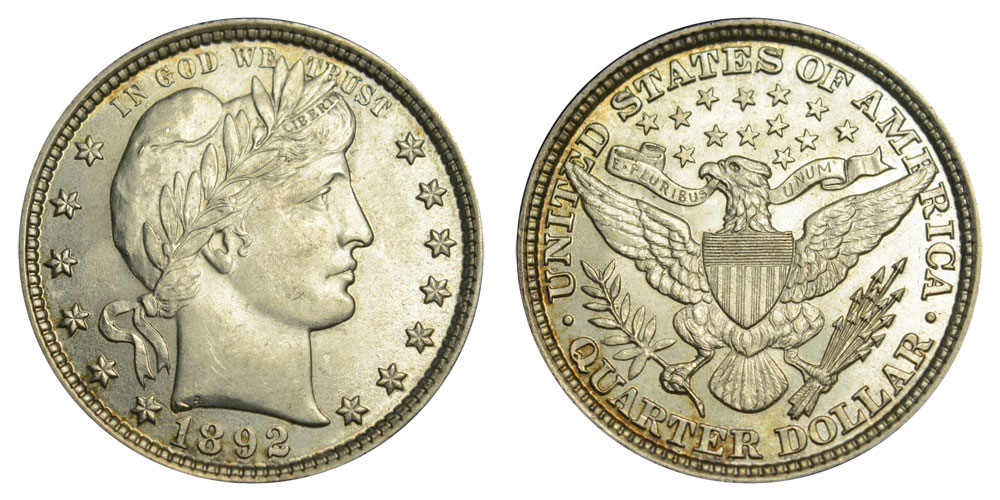Much of our circulating coinage in the USA once had 90% silver content. Which leads to the first question we need to know, "How much Silver is in a Quarter?"
All 25¢ quarters issued in 1964 and years prior had 6.25 grams or almost 1/5th an ounce of silver in each.
Silver Quarter Melt Value Calculator
To calculate how much a silver quarter melt value is, use the following equation and data inputs.
[0.1808 oz] X [current silver spot price] = Silver Quarter worth in silver melt value
For example, the day of publishing this article, the silver spot price is $17.61 X 0.1808 troy ounce silver quarter content = $3.18 silver quarter melt value.
Although today's circulating 25¢ quarters have a ‘silvery’ polish, they don’t contain any pure silver at all. The US Mint currently uses low-value pot metal alloys to strike all US quarters today.
There is a massive difference between the value of the older 90% silver quarters vs. the current base metal quarters struck using an alloy of copper and nickel.
At the time of writing this silver quarter value update and silver melt value bog, the melt value of pre1964 silver quarters is currently worth over 84Xs the value of modern copper-nickel alloyed quarters struck from 1965 to the present day. of course their 25¢ legal tender face values are somehow still equivalent, but people are not dumb and thus Gresham's Law remains in effect today.
All pre-1965 silver quarters are silver coins containing 0.1808 troy ounces (6.25 grams) of physical silver weight and value. Older silver quarters are thus worth over 8000% more than their present-day cupro-nickel versions (over $3 a silver quarter melt value vs just over 3¢ in current quarter melt value). For example the 2019 American Silver Eagle coin has purity of 0.999 and weight 1 troy oz
Silver Quarters Worth a lot to Our Customers
History of the US Quarter Dollar Coin
In the Coinage Act of 1792, the US Congress defined monetary weights and measures in exact figures.
The original definition of one US dollar (as in $1.00) is a specific weight and purity of silver bullion.
Here it is straight from the 1792 Coinage Act:
Dollars or the same is now current, and to contain three hundred and seventy-one grains and four sixteenth parts of a grain of pure, or four hundred and sixteen grains of standard silver, Half Dollars—each to be of half the value of the dollar or unit, and to contain one hundred and eighty-five grains and ten sixteenth parts of a grain of pure, or two hundred and eights of a grain of standard silver. Quarter Dollars—each to be of one fourth the value of the dollar or unit, and to contain ninety-two grains and thirteen sixteenth parts of a grain of pure, or one hundred and four grains of standard silver. Dismes—each to be of the value of one tenth of a dollar or unit, and to contain thirty seven grains and two sixteenth parts of a grain of pure, or forty one grains and three fifth parts of a grain of standard silver.
The fact that they are “weights and measures” is essential. It’s a simple, divisible system of accountability, fraction based. That is to say, $1.00 is a specific weight and purity of the silver, and a half dollar ($.50) is half of that weight (with the same purity). A quarter dollar ($.25) is one quarter the weight (with the same purity) as one dollar. A dime ($.10) is one-tenth of the mass (with the same purity) as one dollar.
The 89th US Congress enacted the Coinage Act of 1965 in response to the growing value of pure silver and the resulting rise in minting costs. Under this Act, the USA eliminated silver from all circulating dimes (10¢) and quarter-dollar (25¢) coins.
There are five different US quarters which contain 0.1808 troy ounces (6.25 grams) of 90% silver content.
Silver Quarters once struck in the USA containing 90% Silver
1. Bust Silver Quarter (1796-1838)

2. Seated Liberty Silver Quarter (1836-1891)

3. Barber Silver Quarter (1892-1916)

4. Standing Liberty Silver Quarter (1916-1930)

5. Washington Silver Quarter (1932-1964)

Silver Quarter Melt Values Protect Savings from Compounding Price Inflation
Learn more best practices on how to both buy bullion
and sell bullion with our free SD Bullion Guide
***

















